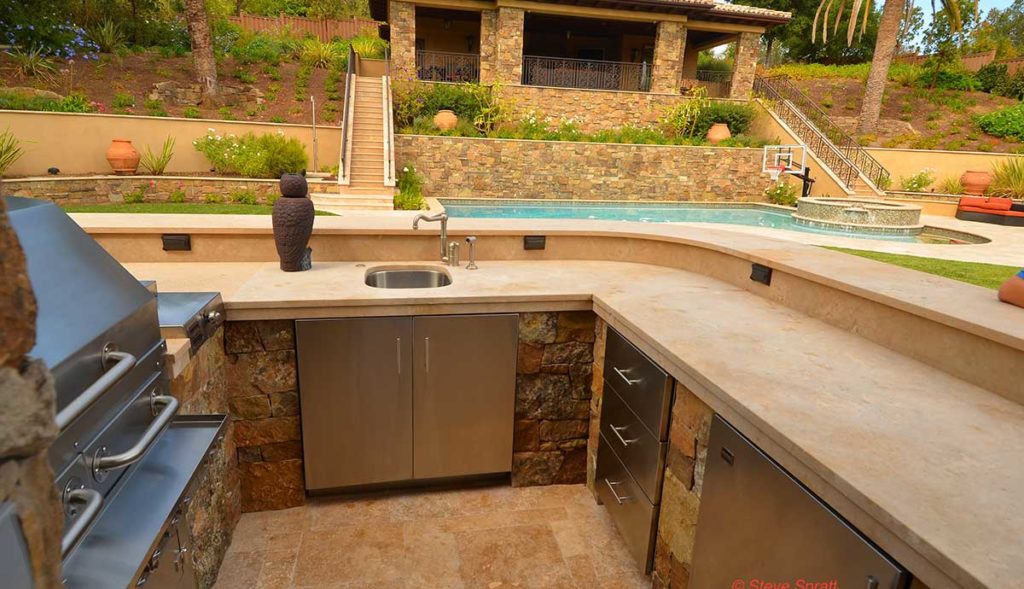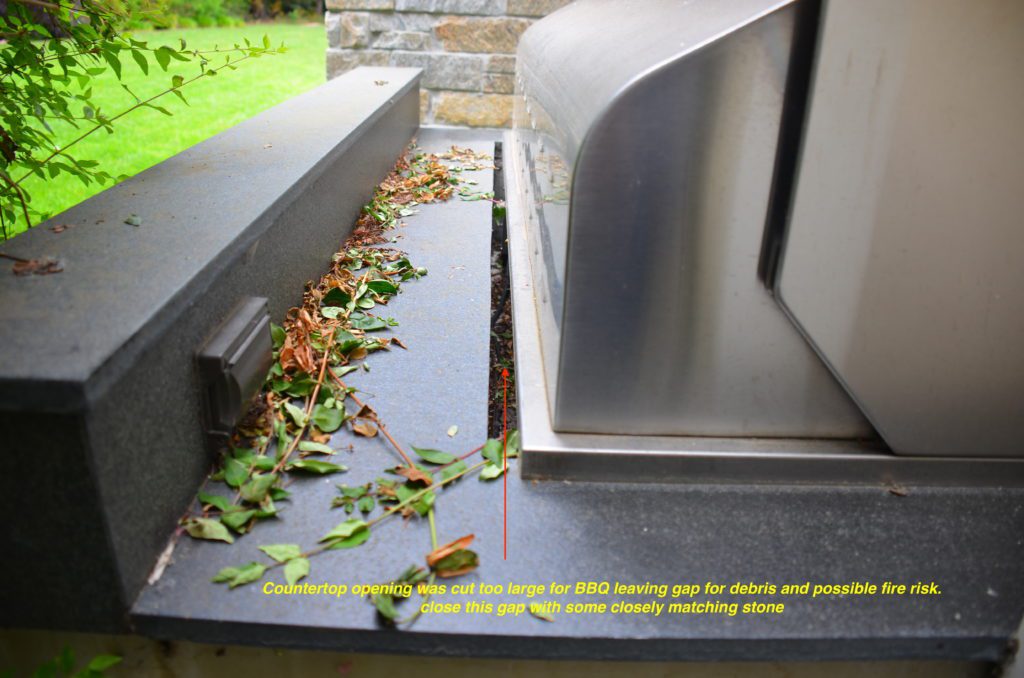Outdoor Kitchen Mistakes Homeowners Must Avoid

Last year a new client came to HPS to enroll a gorgeous new contemporary home into our Stewardship program. During our start-up inspection we were startled to find a BBQ island on the back patio that had caught fire and burned. When asked about the fire our client reported that during his first cookout, the island had simply burst into flames. The expensive stainless BBQ was ruined, and its supporting base cabinet was a total loss too.
The original developer/contractor had disappeared, so our client asked us to fix it. During the repair we uncovered a number of construction mistakes that ultimately led to the fire. I’ve shared these mistakes below to help future outdoor kitchen installers avoid similar results. Homeowners can add more value and enjoyment to their home by following these tips:
-
-
The installation did not include an insulated BBQ liner/jacket
Every built-in BBQ, especially if the counter boxes are built with a combustible material, should be installed with an insulated metal grill liner. This is a kind of protective metal jacket for your grill. Many outdoor kitchens have gone down in flames solely because an insulated grill jacket was not installed with the grill.
Insulated grill jackets surround the BBQ and prevent heat from transferring into the cabinet structure. These devices will prevent any melting, burning, warping or fires. The jackets also provide the additional benefit of supporting and protecting your grills undercarriage from premature weathering and corrosion.

Insulated BBQ jacket Many designers leave these protective liners out of the plans either because they don’t know about them, or they dislike their appearance. Cumbersome looking or not, they are an absolute necessity when building your outdoor kitchen with or without any combustible materials.
Installing an insulated grill jacket will ensure your outdoor kitchen will last for many years of cookouts. NOTE: Not all BBQ brands offer these protective liners for their appliances. Make sure you purchase your grill from a brand that does, or plan to have one custom made for your application.
-
The BBQ cabinet box was not fitted with vent panels.

BBQ cabinet vent panels When using a natural gas or propane BBQ, the enclosure cabinet must be properly vented to prevent an accidental explosion. During construction, the proper placement of the vents is critical. Install vent panels every four feet along the length of the structure to prevent any possible leaking gases from building up.
The type of gas you are using will dictate where each vent panel is installed on the cabinet. If using natural gas (NG), make sure to install each vent panel as high as possible on the body of the island because natural gas rises. When using propane (LP), make sure to install the vents as low as possible on the cabinet since propane is a heavier gas that sinks.
Always use a licensed contractor who knows the codes for natural gas and propane installations. You might save a few bucks by attempting to do this yourself, or leaving out the proper vents entirely. But you could also end up having to replace your entire outdoor kitchen, or home, or possibly seriously injuring someone.
-
Cabinet drawers blocked access to the plumbing

Outdoor BBQ cabinet drawers Having drawers in your outdoor kitchen cabinets can be very useful, but always consider the placement layout beforehand. Many outdoor kitchen owners purchase drawers units for the cabinets, then realize they need to have access for plumbing. This is also a common issue with grills because the gas or propane plumbing requires access.
When planning your outdoor kitchen, think carefully about the placement of your doors and drawers, and whether or not you can install appliances in the given space. Instead you may just want to use access doors that open into the existing void space of the island structure.
-
Make sure the cabinet and appliances are outdoor rated.
When equipping your outdoor kitchen, buy only appliances that are rated for exterior use by the manufacturer. Outdoor units are “hardened” to insure safety and durability when exposed to harsh weather. Indoor appliances are just not up to an environment that may subject it to humidity, heat, cold, blowing sand, rain, rodents and sunshine. In very short order, using indoor appliances outdoors will lead to problems. The appliances finish will become discolored or the unit may fail completely. You can be assured that your warranty will be nullified. It is also a good idea to order a custom cover for the entire countertop. This will protect it from the elements when not in use or during the off-season.
Outdoor cabinets and enclosures also need to be constructed ideally of steel or concrete in order to remove the possibility of dry rot, fire or rodent access. You can order pre-fabricated outdoor kitchen cabinets from Amazon here. Or here.

Make sure you have one of these -
Never install your cooking and cooling appliances next to each other.
When designing an outdoor kitchen always separate the cooking appliances from the cooling appliances. Never install a refrigerator directly underneath or adjacent to your grill. Excessive heat means the refer will have to work much harder than it should. Overheating the internal parts can easily become a cause for them to fail sooner. If space is tight, install your refer at least one foot from your grill or side burner. Make sure a solid barrier is placed between the two appliances inside the island structure. A good layout will help your appliances operate at a reasonable temperature and as a result, last longer.
For safety purposes, design to prevent people from using the refrigerator with close exposure to the hot grill, either directly, next to, or above them.
-
Know your appliances dimensions before making cut-outs.
It is frustrating and expensive to have your cabinet spaces or countertops pre-cut for your appliances, only to find out they do not fit when it’s time to install them. Double and triple check the exact dimensions for the built-in pieces before making any cuts. If possible, it is always best to have the actual products on-hand to measure them for accuracy and a good fit. If you are using a stone slab countertop make sure the top fabricator templates the area just like they would for the kitchen. The rule of “measure twice and cut once” is especially important when working with stone.

Countertop cut too large for the BBQ-this allows debris to fall in creating fire risk -
Don’t forget to leave some extra counter space.
Like most homeowners, you likely want to deck out your new outdoor kitchen with all sorts of appliances, for all kinds of cooking drink mixing and entertaining. However, not many appliances actually are rated for outdoor use. Mixers, coffee makers, microwaves etc. can all be ruined by a surprise rain, an errant sprinkler or even a heavy dew. So don’t leave these non-rated appliances outside.
Also, in all the excitement don’t forget the importance of empty counter space. It is best to leave plenty of empty counter space for things like food preparation, serving, eating and staging. When designing your outdoor kitchen, make sure you leave plenty of work space on the countertop for easy and convenient use.
-
Do your research and choose reliable appliances
There are tons of outdoor appliances on the market and it can be hard to choose the perfect products for you. Everyone wants great looking and functional appliances, but the important characteristic is durability. For that reason, its most important to do your homework before buying. An outdoor kitchen is something you want to last for many years, so it is crucial to select the perfect appliances when building.
-
Summary
Avoid the mistakes discussed above when designing your outdoor BBQ kitchen. Take time creating a good appliance layout. Read over any available customer and expert reviews. Research how well the appliance performs and only select products that are made for the outdoors. By doing your research beforehand, you will be much happier with your choices in the years to come. See How to Buy a BBQ. Contact me at info.homepreservation.com if you would like more information about planning and and constructing a quality outdoor kitchen area.














